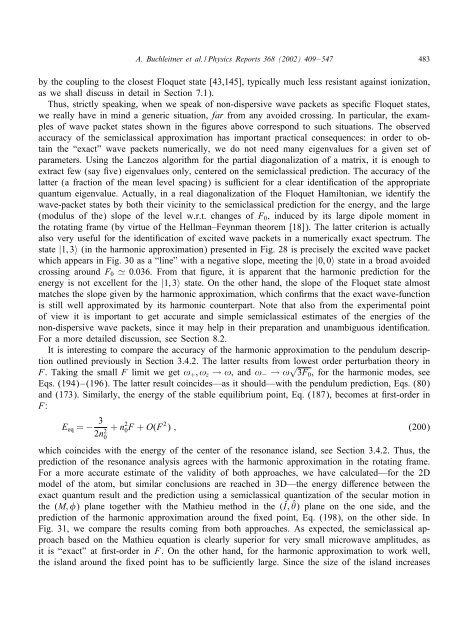Non-dispersive wave packets in periodically driven quantum systems
Non-dispersive wave packets in periodically driven quantum systems
Non-dispersive wave packets in periodically driven quantum systems
You also want an ePaper? Increase the reach of your titles
YUMPU automatically turns print PDFs into web optimized ePapers that Google loves.
A. Buchleitner et al. / Physics Reports 368 (2002) 409–547 483<br />
by the coupl<strong>in</strong>g to the closest Floquet state [43,145], typically much less resistant aga<strong>in</strong>st ionization,<br />
as we shall discuss <strong>in</strong> detail <strong>in</strong> Section 7.1).<br />
Thus, strictly speak<strong>in</strong>g, when we speak of non-<strong>dispersive</strong> <strong>wave</strong> <strong>packets</strong> as speci c Floquet states,<br />
we really have <strong>in</strong> m<strong>in</strong>d a generic situation, far from any avoided cross<strong>in</strong>g. In particular, the examples<br />
of <strong>wave</strong> packet states shown <strong>in</strong> the gures above correspond to such situations. The observed<br />
accuracy of the semiclassical approximation has important practical consequences: <strong>in</strong> order to obta<strong>in</strong><br />
the “exact” <strong>wave</strong> <strong>packets</strong> numerically, we do not need many eigenvalues for a given set of<br />
parameters. Us<strong>in</strong>g the Lanczos algorithm for the partial diagonalization of a matrix, it is enough to<br />
extract few (say ve) eigenvalues only, centered on the semiclassical prediction. The accuracy of the<br />
latter (a fraction of the mean level spac<strong>in</strong>g) is su cient for a clear identi cation of the appropriate<br />
<strong>quantum</strong> eigenvalue. Actually, <strong>in</strong> a real diagonalization of the Floquet Hamiltonian, we identify the<br />
<strong>wave</strong>-packet states by both their vic<strong>in</strong>ity to the semiclassical prediction for the energy, and the large<br />
(modulus of the) slope of the level w.r.t. changes of F0, <strong>in</strong>duced by its large dipole moment <strong>in</strong><br />
the rotat<strong>in</strong>g frame (by virtue of the Hellman–Feynman theorem [18]). The latter criterion is actually<br />
also very useful for the identi cation of excited <strong>wave</strong> <strong>packets</strong> <strong>in</strong> a numerically exact spectrum. The<br />
state |1; 3〉 (<strong>in</strong> the harmonic approximation) presented <strong>in</strong> Fig. 28 is precisely the excited <strong>wave</strong> packet<br />
which appears <strong>in</strong> Fig. 30 as a “l<strong>in</strong>e” with a negative slope, meet<strong>in</strong>g the |0; 0〉 state <strong>in</strong> a broad avoided<br />
cross<strong>in</strong>g around F0 0:036. From that gure, it is apparent that the harmonic prediction for the<br />
energy is not excellent for the |1; 3〉 state. On the other hand, the slope of the Floquet state almost<br />
matches the slope given by the harmonic approximation, which con rms that the exact <strong>wave</strong>-function<br />
is still well approximated by its harmonic counterpart. Note that also from the experimental po<strong>in</strong>t<br />
of view it is important to get accurate and simple semiclassical estimates of the energies of the<br />
non-<strong>dispersive</strong> <strong>wave</strong> <strong>packets</strong>, s<strong>in</strong>ce it may help <strong>in</strong> their preparation and unambiguous identi cation.<br />
For a more detailed discussion, see Section 8.2.<br />
It is <strong>in</strong>terest<strong>in</strong>g to compare the accuracy of the harmonic approximation to the pendulum description<br />
outl<strong>in</strong>ed previously <strong>in</strong> Section 3.4.2. The latter results from lowest order perturbation theory <strong>in</strong><br />
F. Tak<strong>in</strong>g the small F limit we get !+;!z → !, and !− → ! √ 3F0, for the harmonic modes, see<br />
Eqs. (194)–(196). The latter result co<strong>in</strong>cides—as it should—with the pendulum prediction, Eqs. (80)<br />
and (173). Similarly, the energy of the stable equilibrium po<strong>in</strong>t, Eq. (187), becomes at rst-order <strong>in</strong><br />
F:<br />
Eeq = − 3<br />
2n2 + n<br />
0<br />
2 0F + O(F 2 ) ; (200)<br />
which co<strong>in</strong>cides with the energy of the center of the resonance island, see Section 3.4.2. Thus, the<br />
prediction of the resonance analysis agrees with the harmonic approximation <strong>in</strong> the rotat<strong>in</strong>g frame.<br />
For a more accurate estimate of the validity of both approaches, we have calculated—for the 2D<br />
model of the atom, but similar conclusions are reached <strong>in</strong> 3D—the energy di erence between the<br />
exact <strong>quantum</strong> result and the prediction us<strong>in</strong>g a semiclassical quantization of the secular motion <strong>in</strong><br />
the (M; ) plane together with the Mathieu method <strong>in</strong> the (Î; ˆ ) plane on the one side, and the<br />
prediction of the harmonic approximation around the xed po<strong>in</strong>t, Eq. (198), on the other side. In<br />
Fig. 31, we compare the results com<strong>in</strong>g from both approaches. As expected, the semiclassical approach<br />
based on the Mathieu equation is clearly superior for very small micro<strong>wave</strong> amplitudes, as<br />
it is “exact” at rst-order <strong>in</strong> F. On the other hand, for the harmonic approximation to work well,<br />
the island around the xed po<strong>in</strong>t has to be su ciently large. S<strong>in</strong>ce the size of the island <strong>in</strong>creases











